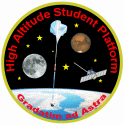



Payload 03 Information
Payload Flight Number:
Institution:
Payload Title:
High Altitude X-Ray Detector Testbed
Student Leader:
Faculty Advisor:
Payload class:
SMALL
Payload ID Number:
03
Mass:
2.34 kg
Current:
385 mA
Serial Downlink:
Yes
Analog Downlink:
Serial Commands:
Yes
Discrete Commands:
Payload Specification & Integration Plan
Due: 06/21/2013
Delivered:
Payload Integration Certification
Scheduled: 08/02/2013
Actual:
Flight Operation Plan
Due: 07/26/2013
Delivered:
Final Flight / Science Report
Due: 12/13/2013
Delivered:
Abstract:
The work described in this proposal is motivated by the idea of using celestial x-ray sources such as pulsars as beacons for deep space navigation. The development of a compact x-ray detector system is an enabler of this concept. The engineering objective of the experiment being proposed is to upgrade the compact X-ray detector and its associated hardware that flew on the 2012 HASP mission. These upgrades include the addition of a second scintillation detector and a multi-channel analyzer to detect the energy level of the detected cosmic rays, and the addition of shielding to the detector so as to limit it to a field of view. The scientific objectives of the experiment are to separate individual cosmic ray events into different energy bands, and to examine periods of higher photon flux in these bands along the flight trajectory for possible celestial body identification during flight. Another scientific goal is to characterize the cosmic ray background, and thus the signal-to-noise ratio (SNR) as seen by such small detectors in these separate energy bands. The educational objective is to provide students with a hands-on experience in designing and testing of avionics systems. The 2013 HAXDT will be designed to conform to a 3-U CubeSat infrastructure with a 3000 cm3 internal payload volume. Current interface requirements include less than 15 watts of power, and 440 bps of downlink bandwidth. |